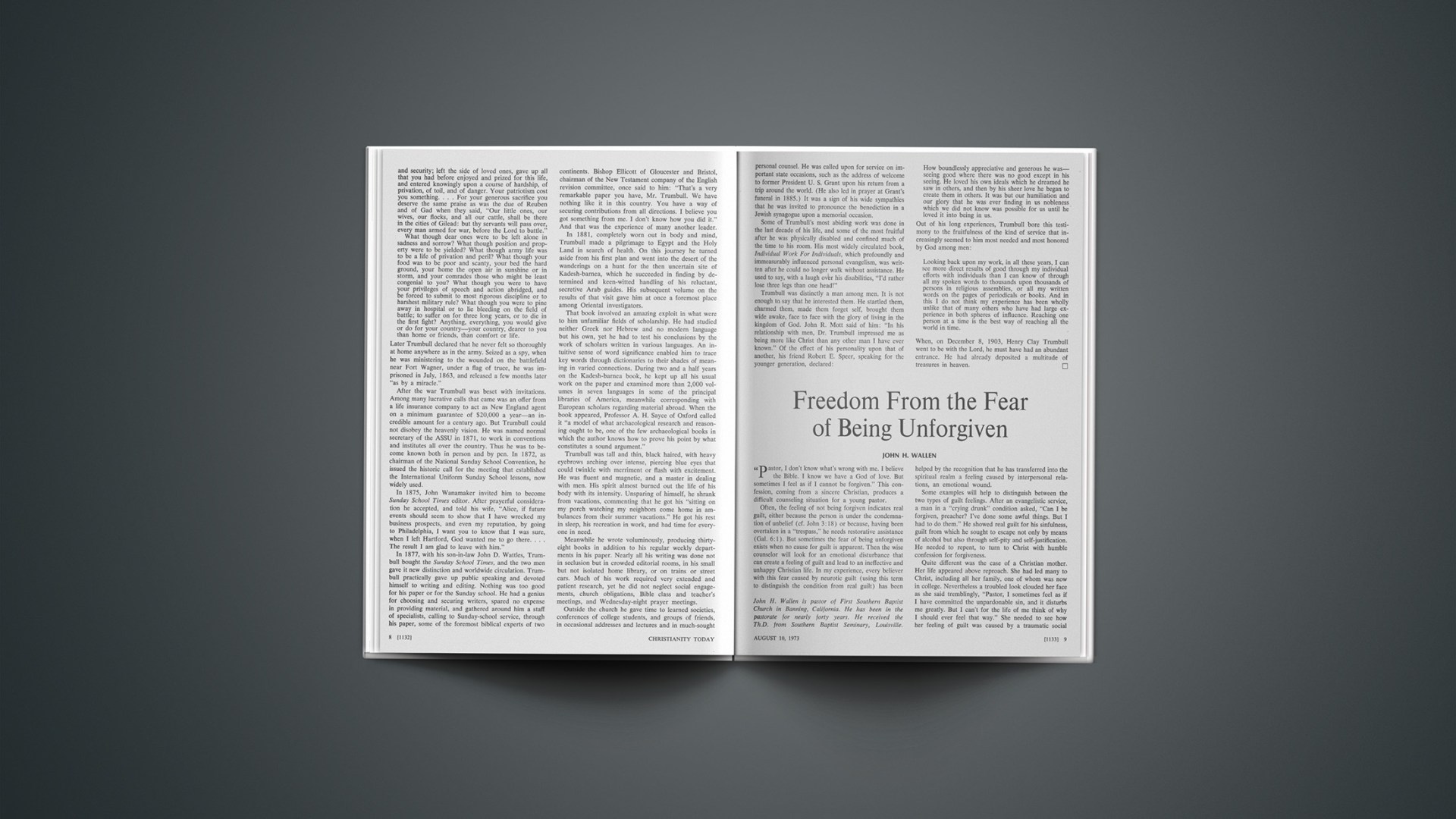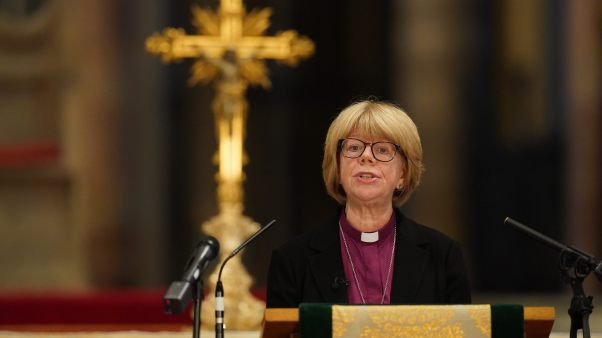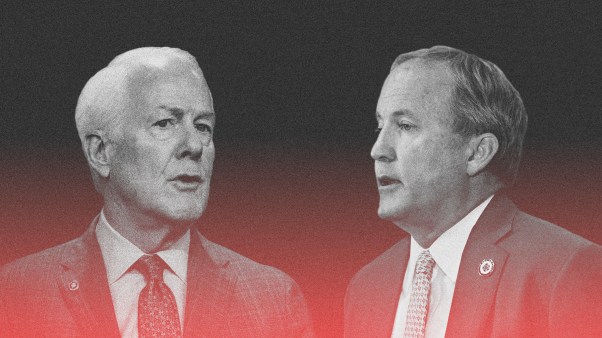That 1973 marks the 400th anniversary of Martin Chemnitz’s Examen Concilii Tridentini is likely to be little remembered. Who, after all, was Chemnitz? (A few World War II GI’s may remember that they had the German city Chemnitz—now renamed Karl-Marx-Stadt by the Communists—in their sights when the controversial pull-back order was given.) And what was the significance of his Examination of the Council of Trent?
Even most Lutherans have probably never heard of Chemnitz. Yet he was chief architect of the Formula of Concord (1577), the document that did more than anything else to heal the sore divisions in the Lutheran church after Luther’s death (1546) and is still a confessional standard for some Lutheran bodies. Perhaps Chemnitz was not the creative genius Martin Luther had been, but he was an uncommon man for an uncommonly difficult time. The tides of the Reformation had peaked, and the Counter Reformation had set in. Chemnitz, as no other, kept the Reformation cause on course in the second half of the sixteenth century. His opponents knew his worth and mettle. “You Protestants have two Martins; if the second had not come, the first would not have endured” is the way his Catholic contemporaries assessed the brilliant theologian of Braunschweig.
But what present bearing has Chemnitz’s exhaustive response to the canons and decrees of the Council of Trent? David F. Wells argues in Revolution in Rome that Vatican II “erected a tombstone” over the myth that Rome never changes. “Both the spirit and the doctrines of Catholicism are changing,” he says, and therefore “the future is not in the hands of the conservatives and even less under the control of Pope Paul VI.” Some of the Protestant observers at Vatican II shared the view that there was a new openness in Rome, profundity of scholarship on display, especially in biblical studies, and a refreshingly evangelical and ecumenical outlook. Perhaps none spoke more earnestly and lovingly for reunion in Christendom than the late, widely esteemed and scholarly Augustin Cardinal Bea.
Part of the problem is the difficulty of explaining or defining exactly what Catholicism is. Do “progressives” like Hans Küng, Yves Congar, Karl Rahner, Gregory Baum, Cardinal Leo Suenens of Belgium, and Edward Schillebeeckx speak for Rome? Without question they excite considerable response, at least among Catholic intellectuals. And when their views are translated downward, it seems that what they are saying is what many people in the pew wish their church would say and do.
On the other hand, articulate voices within Catholicism doubt that the church’s mind is really being heard through the “progressives.” In Has the Catholic Church Gone Mad? (Arlington House, 1972), John Eppstein, an aroused Catholic layman and British journalist, provides a provocative counterfoil to Wells’s analysis. Eppstein delves directly into many troubled areas. He deplores quite frankly the “shenanigans” of avant-garde theological gadflies, comes up with evidence that Vatican II upheld the papal right to hand down irrevocable decisions infallibly, and, dismissing the notion that the pope’s power devolves on him “from below,” “from the consent of the Church,” asserts the old position that his office “devolves upon him from above,” as “the successor of Peter.” Such thinking, according to Eppstein, “has a truer ring in the ears of the ordinary Catholic than the notion of the Pope as simply primus inter pares which the advocates of the ‘Conciliar Church’ have been propagating as a step to corporate reunion.” For a parting shot Eppstein poses a proposition that seems to set Catholic thinking back into its regular channel:
Whether the calling of the Vatican Council was inspired by the Holy Ghost, or whether, as it seems to the uncommitted historian judging by the results, it was an act of monumental imprudence, Paul VI, confronted with its aftermath, has undoubtedly deserved well of his people [159].
What Eppstein means is simply that, except for a few minor changes that do not affect papal authority or the corpus doctrinae, Rome is unchanged.
Obviously such an interpretation is open to debate. However, nothing seems to lend as much credibility to Eppstein’s position as does the current debate between Küng and Rahner over infallibility in the papal teaching office. Küng’s Infallibility? An Inquiry (Doubleday, 1971) termed it “the neuralgic point” and a historical blunder. Rahner, refusing the role of sorcerer’s apprentice for having conjured up more than he could handle in his erstwhile disciple (Küng), has rallied more than a dozen redoubtable “progressives” to his side in defense of papal authority and infallibility (Zum Problem Unfehlbarkeit, 1971). Under Pope Paul VI’s careful, patient, but firm prodding, the church’s leading theologians have dutifully acknowledged the protective umbrella of papal supremacy, jure divino.
Changing times have brought about contemporaneity in such things as biblical studies and translations, new liturgical forms, use of the vernacular in the Mass, greater congregational participation, “both kinds” at certain times in Communion, freer, more generous relations with “separated brethren,” relaxation of fasting rules, and, just recently, permission for lay persons, including women, to distribute Communion wafers. Yet authoritative voices, from the Vatican on down through the bishops and the universities, remind us that there have been no changes in the fundamental articles that were the rupture points at the time of the Reformation. Examples of these are: that the justification of the sinner depends on his interior renewal and subsequent performance of good works; the whole doctrine of the church, its nature and power, particularly the power vested in the hierarchy as rulers in the church; the sacraments as the means of dispensing “sanctifying grace” under the sacerdotal, jurisdictional authority of the church and its priesthood. No part of Trent’s decrees and canons on these central issues has ever been retracted.
The “siege-mentality,” once so typical of Catholic defensiveness on Trent, has, it is true, been lifted in favor of open and frank dialogue. Yet Vittorio Subilia, professor of systematic theology at the Waldensian Seminary in Rome, insists in The Problem of Catholicism that “the so-called new line in Catholic ecumenism differs from earlier lines in its dogmatic pre-suppositions only circumstantially and superficially, and not at all in depth.” This would appear to bear out the shallowness of some of the theological gymnastics of recent times, particularly the efforts to prove that Reformation standards like sola Scriptura, sola gratia, and sola fide belong as much to Rome as to the Reformation churches, and that Luther stood closer to Aquinas on sola gratia, for example, than he realized. In fact, “by clever documentation,” avers Klaas Runia, “Luther is made to look like a Catholic and the Fathers of Trent like Lutherans” (CHRISTIANITY TODAY, “The Church of Rome and the Reformation Churches,” June 18, 1964).
Salvation by grace alone had become, obviously, a not entirely unambiguous concept. Catholics were claiming it for Aquinas as urgently as Lutherans for Luther. But the fundamental difference remained nonetheless. For Aquinas the concept was wrapped up in theologia gloriae, theology of glory (man ascending progressively to the beautific vision through the enabling “sanctifying grace” of God infused into the sinner through the church’s ministration of the sevenfold sacramental system); for Luther it was completely theologia crucis, theology of the cross (God in his forgiving grace coming to sinners in his Son, pronouncing them righteous freely and fully for Christ’s sake, solely on account of the Saviour’s meritorious suffering and death). Man’s salvation, or justification, in no way rested on performance, not even when prompted by “sanctifying grace,” said Luther; it rested on promise, offered freely in Word (Gospel) and Sacrament (Baptism and the Lord’s Supper), and was to be received, therefore, alone by faith apart from the works of the Law. The believer’s life blossoms with many good works, Luther emphasized; but just as emphatically he pounded home, on Scripture’s authority, that “thereby am I not justified.” Werner Elert credits Chemnitz with making it crystal clear in his Examen that there was no bridging of this difference between Trent and the Reformation position on the sinner’s justification before God (Structure of Lutheranism).
Hence the contemporary relevance of Chemnitz’s work. Chemnitz was not, of course, Trent’s only challenger. Among others was John Calvin, who wrote a crisp, incisive rebuttal. But none could match Chemnitz’s magnum opus in breadth and penetration. It was begun in 1565 and was eight years in the making. When it appeared in 1573, it was immediately recognized as the definitive work, a sharp sword piercing to the marrow of the issues dividing Rome from the Reformation.
“Luther’s greatest student” never actually sat at the master’s feet in any of his courses at Wittenberg. Born in 1522, at Treuenbrietzen, a small town halfway between Wittenberg and Berlin, Chemnitz had brief contacts with Wittenberg and its famous mentor. But at first his interests lay in quite a different direction. He distinctly remembered Luther’s sermons at the Stadtkirche in Wittenberg, however, along with the last disputation (for a doctoral candidate) that Luther chaired, in 1545. Ruefully Chemnitz admitted in later life: “I did not hear him with due attention.” Not until several years had passed did he turn to serious theological study, mostly through the influence and guidance of Melanchthon.
A fortuitous appointment as librarian at the ducal library in Königsberg gave him the necessary time, tools, and quiet for an intensive, self-directed program of study. Chemnitz concentrated on the Holy Scriptures, working always in the most scholarly fashion from the original Hebrew and Greek; on the early church fathers; and on the writings of Luther. In his own words:
My method was this. First, I read the biblical books through in their order, comparing all the various versions and expositions, old and new, which were in the library, and if I met anything that seemed memorable or remarkable, I made a note of it on paper arranged for this purpose. In the second place, I read the writings of the Fathers, from the earliest antiquity, and what engaged my attention was entered into my notes. In the third place, I diligently read those recent authors who pointed out the fundamentals of the purified doctrines, and chiefly those who wrote polemical treatises on the controversies of our time, the arguments of the Papists, Anabaptists, Sacramentarians, and from what foundations the explanations and solutions were to be taken, and what solutions were best. The notes I made of all these things in my memoranda I still have and often inspect with great delight and profit [for Chemnitz’s autobiographical notes, as well as a fuller account of his life, see the author’s From Luther to Chemnitz on Scripture and the Word, Eerdmans, 1971, pp. 115–40 passim].
Königsberg was Chemnitz’s “tower experience.” For a short time, 1553–54, he was back in Wittenberg, lecturing on systematic theology at Melanchthon’s request and in his place. Shortly thereafter, having qualified for the pastoral and preaching ministry, Chemnitz assumed duties in Braunschweig that soon led to the superintendency of the territorial church, a post he held till the end of his life, 1586. A leave of absence in 1567 allowed him to complete a doctorate in theology at the University of Rostock.
Administrative duties never dulled Chemnitz’s scholarly bent. In constant demand for Gutachten (position papers on sundry theological questions), he also initiated through regular lectures for the clergy of his territory what probably was the first in-service theological-enrichment program. These lectures were published after his death as his Loci Theologici and became the model of all the great dogmatics of the silver age of theology in the seventeenth century. His work on Christology, De duabus naturis in Christo (recently translated by J. A. O. Preus, The Two Natures in Christ), has been called the greatest piece on Christology since Athanasius. Also from his prolific pen came a fine Harmony of the Gospels, a Gospel Postil (sermon book for home use), and a brilliant little handbook, or enchiridion, on doctrine for pastors and laymen. Before the publication of his monumental Examen in 1573, he had already produced a shorter response to the Jesuits, who were just beginning to make their influence felt.
But for the Church at large, Chemnitz’s enduring place in history was to rest on his answer to Trent. He knew that council had scored deeply, not least through the interpretive commentary of Payva d’Andrada, one of the periti (experts) present at the closing sessions and a spokesman for the Jesuits, though not a Jesuit himself. Chemnitz was convinced that only a thorough, definitive work would suffice against Trent’s devastating assault on Reformation theology. The result was his Examen, beautifully, brilliantly arranged and written; in his usual clear, unambiguous style (even his original Latin is a pleasure to read!); expertly supported in all parts by sound biblical exegesis and other references; evangelical in tone throughout, and polemical only when necessary. The splendid Berlin edition of 1861 puts the whole of the Latin text, 1,000 double-column pages, under one cover. The first volume of an English version is now available from Concordia Publishing House, translated by Fred Kramer, 1971, covering chiefly the following topics: Scripture, traditions, sin, free will, justification, faith, good works.
Chemnitz had given the world what has to be recognized as one of the greatest summaries and defenses of the evangelical faith ever written. Even his opponents were awed. One chronicler of the period, C. G. H. Lentz, notes that many Catholics, including Jesuits, were won over by Chemnitz’s masterly apologetic for the evangelical faith. Rome has never successfully mounted a reply, apparently content to let time pass it by as long as Protestants are satisfied to do the same.
Evaluations from the Protestant side vary and are scarce in recent years, chiefly, no doubt, because the work was “hidden away” in Latin. Those familiar with it divide on its present significance. R. Mumm (Die Polemik des Martin Chemnitz gegen das Konzil von Trient, 1905) judged it a masterpiece but a historical monument, of no contemporary import. Wilhelm Pauck, disagreeing completely, said that in his judgment Chemnitz showed for all time “that not Protestantism but Roman Catholicism could justly be accused of having fallen away from the teachings and practices of the ancient church” (The Heritage of the Reformation).
Catholic interpreters themselves divide on the meaning of Trent’s famous dictum that unwritten traditions should be received and venerated “with an equal affection of piety and reverence” as the inspired Scriptures themselves. Josef Geiselmann and Georges Tavard, among others, have tried hard to soften the sharpness with which Trent set Scripture and tradition side by side as dual authorities: Trent’s meaning, they claim, was to emphasize as “coinherence” of Scripture and tradition through and under the living voice of the church. They try to make Trent sound like a supporter of sola Scriptura.
A few Protestant scholars—for example, G. C. Berkouwer (The Second Vatican Council and the New Catholicism)—have been willing to grant considerable credence to this view. However, the Catholic scholar Heinrich Lennerz disagrees totally with these reinterpretations and affirms simply that Trent did indeed speak of a two-source basis in the sense that Chemnitz scored so severely.
The rightness of this latter, traditional view is borne out by the frank avowal of Joseph Lortz, ranking Catholic historian of our time, that Trent made it absolutely clear, above all else, that “the church was anchored in the papacy” (Geschichte der Kirche). This appears to strengthen the opinion Protestants have shared for a long time that neither Scripture nor tradition but the church itself or the papacy is still the final source of authority for Rome.
Heinrich Bornkamm notes that on the Scripture/tradition question Rome has not budged an inch. “The fundamental rift,” he affirms, “lay in the question of the teaching authority of the church and still remains there”; therefore, “this is where all discussions of individual Catholic and Reformed doctrines, which have or ever can be held, end” (The Heart of Reformation Faith). Accordingly, it is incredible that a scholar of Lortz’s reputation, as well as other Catholic “progressives,” should completely ignore Chemnitz’s Examen, the most incisive, thorough, and unanswered work on Trent!
For that matter, heirs of the Reformation deserve equal chastisement. No serious study or dialogue involving Catholic/Protestant participants should dare to bypass Chemnitz’s great work. To do so is to risk shallow, superficial theologizing. Gerhard Ebeling, usually remembered for the devastating effect of his “new hermeneutic” on biblical content and text, has quite rightly pointed to this weakness. He states:
Careful testing is needed to show whether on the Catholic side the modern interpretation of the relation between Scripture and Tradition in the sense of sola Scriptura, really represents a movement towards the Protestant conception; or whether it should not be regarded as a subtle intensification of the Confessional opposition. Similarly, the question might be raised whether on the Protestant side the serious attention being paid to the problem of Tradition really involves the surrender of the Reformers’ sola Scriptura [The Word of God and Tradition, Fortress, 1968, p. 107].
Few men were as sensitive and attuned to what belonged to the essential and true unity of the Christian Church in his day (or ours, for that matter), as Chemnitz. His utter commitment to the authority of Holy Scripture makes unconscionable any charge that he was merely subjectivist, intellectualist, or, worst of all, rebellious. Chemnitz bowed before God’s Word in a dutiful, servant-like manner like that of Luther. He lived out of the content of God’s Holy Word—what God had there said (Deus locutus) and was even now saying (Deus loquens)—as few men before or after him have done. Not only will Catholic/Protestant dialogues be lifted to a higher plane and a truer bearing point, but so will Christian theology itself, by a fresh look at Chemnitz’s Examination of the Council of Trent.
Debtors owe more than their respects on the 400th anniversary.
George M. Marsden is associate professor of history at Calvin College, Grand Rapids, Michigan. He has the Ph.D. (Yale University) and has written “The Evangelical Mind and the New School Presbyterian Experience.”










